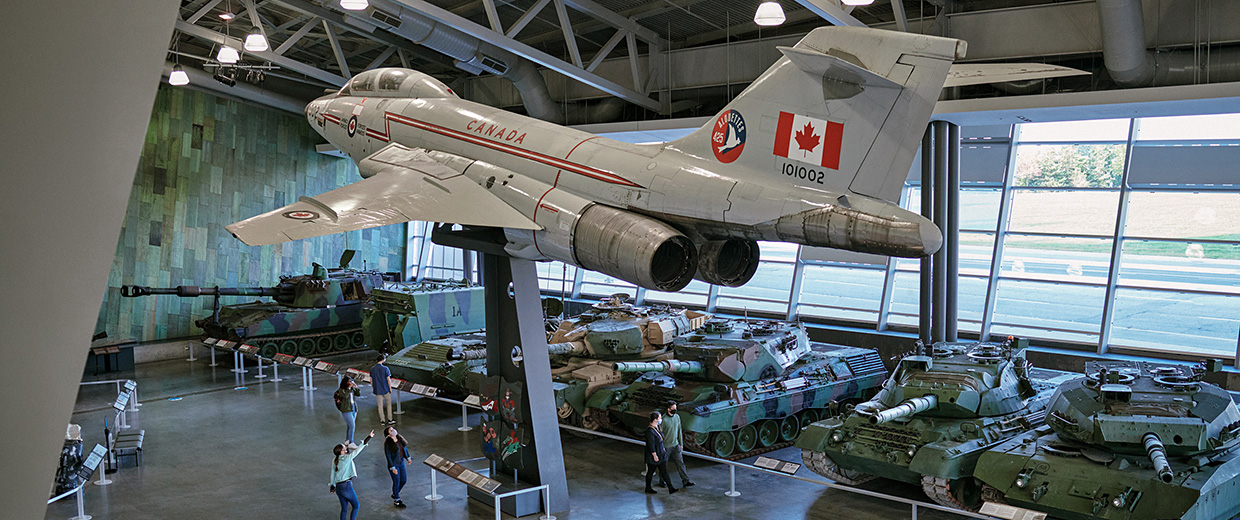We proudly showcase some of the vehicles from our remarkable military vehicle collection — a testament to innovation, resilience and the mechanized might that shaped Canada’s wartime legacy.
This page features a formidable lineup of iconic machines like the Sherman tank, Universal Carrier, and Harley-Davidson motorcycle, each echoing the stories of Canadian soldiers who rode into history.
These steel beasts did more than move troops — they defined battlefront strategies, turned tides and brought humanity face-to-face with industrialized warfare.
This collection invites visitors not only to witness the engineering brilliance of the era but to reflect on the sacrifice and courage embedded in every rivet and tread.
Ram Mk. II Kangaroo

Canadian War Museum
The Ram Mk. II Kangaroo was a Canadian-designed armoured personnel carrier used during the Second World War to safely transport troops across dangerous terrain. Converted from surplus Ram cruiser tanks in 1944, it featured thick armour, no main gun and a low profile to reduce vulnerability in combat. Despite having no seating and a risky top-entry design, Kangaroos were widely used by Canadian and British forces, proving crucial in combined arms operations.
Max Speed: 40 km/h
Used by Canada: 1944–1945
Crew: 2 crew and up to 8 passengers
Armour: Up to 76 mm thick
Weight: 24.5 tonnes
Armament: .30 calibre machine gun
Grizzly Mk. I
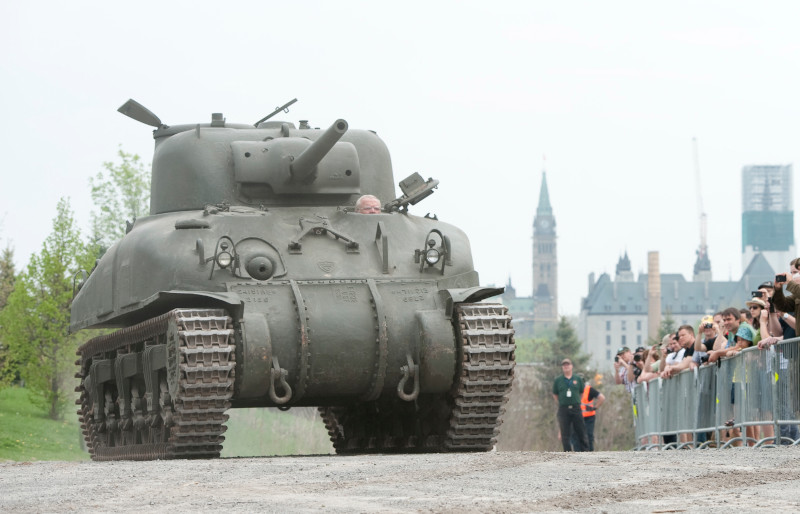
Canadian War Museum
The Grizzly Mk. I was a Canadian-built Sherman variant from 1943, featuring reinforced armour, CDP tracks and other local modifications. Only 188 were made before cancellation in 1944. Used mainly for training, anti-aircraft prototypes and APC conversions, the Canadian War Museum’s restored Grizzly also appeared in Band of Brothers.
Max Speed: 39 km/h
Used by Canada: 1943–1955
Crew: 5
Armour: Up to 75 mm
Weight: 30 tonnes
Armament: 75 mm M3 L/40 main gun and .30 and .50 calibre machine guns
Universal Carrier Mk. II*
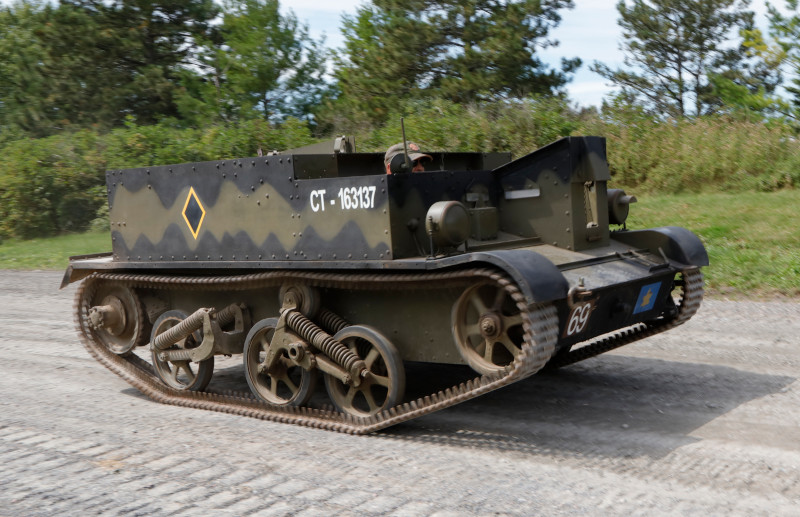
Canadian War Museum
The Universal Carrier Mk. II*, built by Ford of Canada during WWII, was a lightly armoured, tracked vehicle used widely by Allied forces. Over 28,000 were produced in Windsor for roles like mortar carrier and flamethrower platform. The Canadian War Museum’s model, originally a flamethrower variant, was restored in the 1970s as a 3-inch mortar carrier and is planned for return to its original configuration
Maximum speed: 53 km/h
Used by: Canada 1941–1961
Crew: 6
Weight: 4,500 kg
Main armament: Various
M9 Halftrack
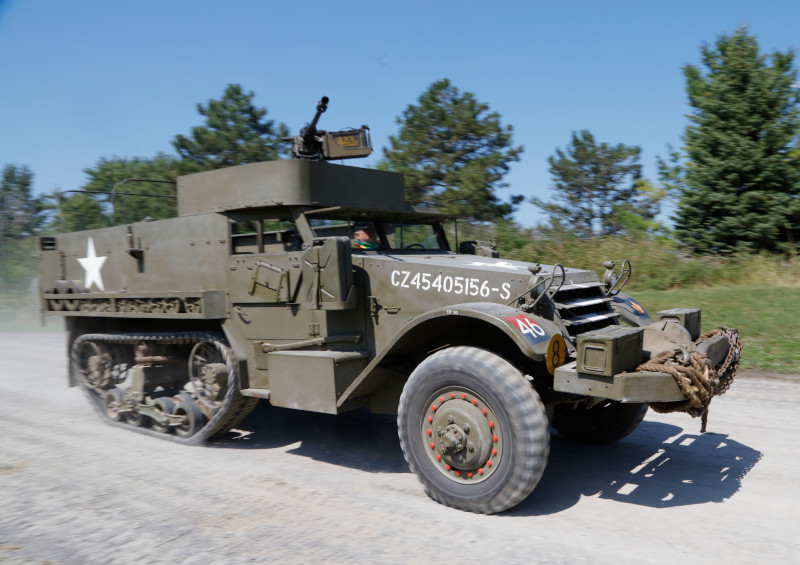
Canadian War Museum
The Canadian Army used American half-tracked armoured trucks like the The M9A1 in Italy and Northwest Europe.
A half-track is a military vehicle with wheels at the front and caterpillar tracks at the rear, as opposed to a full-track, which has only caterpillar tracks and no wheels.
The half-tracks served as armoured personnel carriers, command vehicles, ammunition carriers, and to tow artillery. Its light armour provided some crew and passenger protection from small arms and shell fragments.
This half-track is painted with the markings of the 2nd Canadian Anti-Tank Regiment, which fought through Normandy as part of the 2nd Canadian Infantry Division.
Maximum Speed: 48 km/h
Used by Canada 1942–1945
Capacity : 3 crew, up to 7 passengers
Armour: up to 8 mm thick
Armament : .50 calibre machine gun, .30 calibre machine gun
Harley-Davidson 43WLC motorcycle
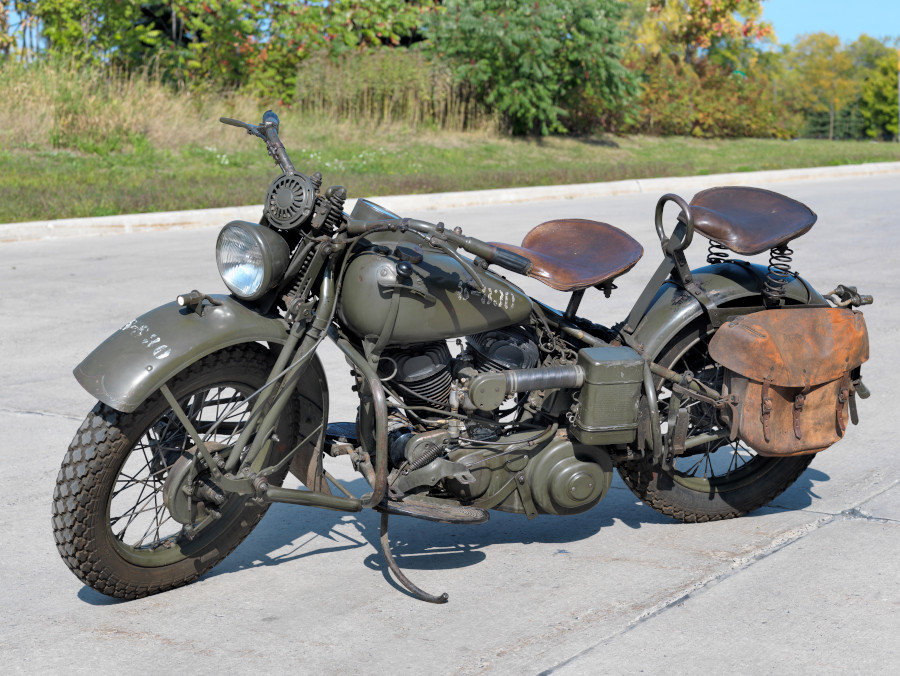
Canadian War Museum
Almost one quarter of the 88,000 Harley-Davidson motorcycles produced during the Second World War were built to Canadian specifications. Canadian dispatch riders and military police used the WLC (WL for its engine type, C for Canadian) model in Canada and overseas in the Second World War and the Korean War.
Post-war North American consumers, many of them former soldiers, eagerly purchased surplus Harley-Davidsons for use in civilian life.
Max Speed: 105 km/h
Used by Canada: 1942–1945
Crew: 1 + 1
Armour: n/a
Weight: 0.25 tonnes
Main Armament: n/a
Sexton Mk. II
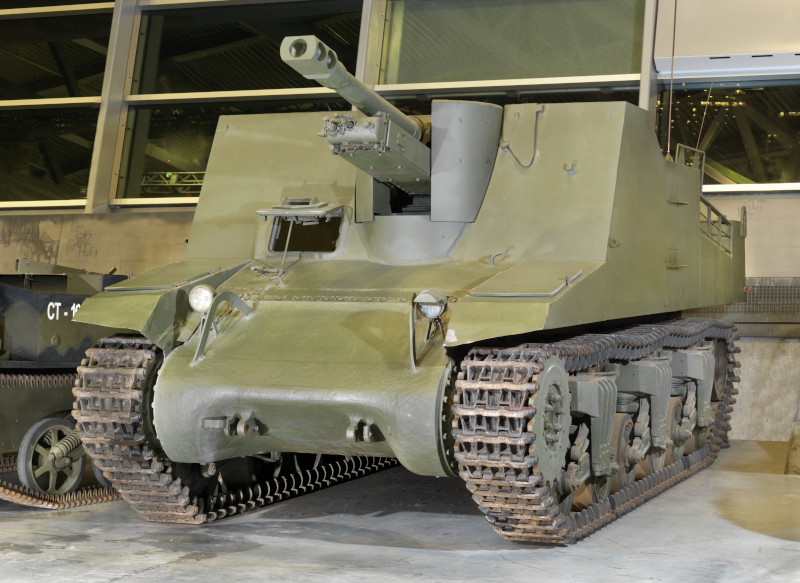
Canadian War Museum
The Sexton Mk. II was a Canadian self-propelled gun built on the Grizzly tank chassis, mounting a QF 25-pounder for mobile artillery support during the Second World War. Reliable and well-armoured, it saw action with Canadian and British forces from Italy to Normandy and remained in service into the 1950s. The Canadian War Museum’s restored example, built in 1944, once served in Portugal and features Canadian-made CDP tracks and VVSS suspension.
Max Speed: 40 km/h
Used by Canada: 1943–1957
Crew: 6
Armour: Up to 32 mm thick
Weight: 25 tonnes
Main Armament: Ordnance QF 25-pounder gun
M113 C&R Lynx Reconnaissance Vehicle
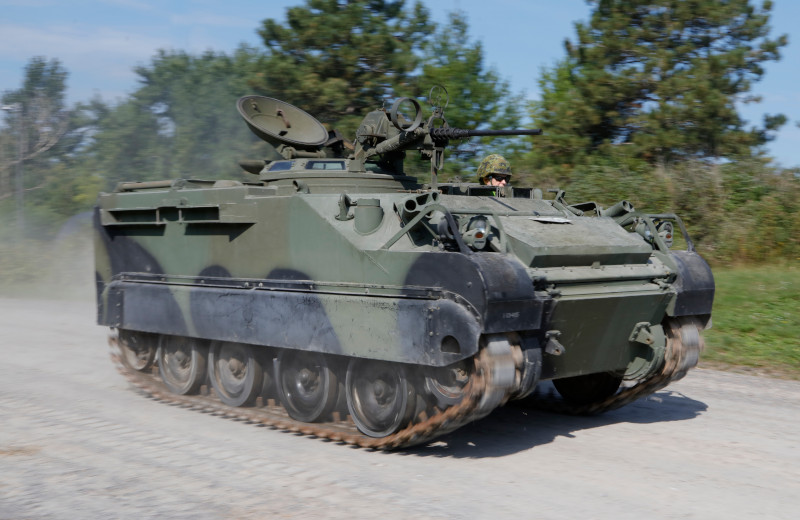
Canadian War Museum
The fast, lightly armoured Lynx carried communications equipment and acted as a mobile headquarters or scouting vehicle. It floated and could cross water obstacles at up to 6 kilometres per hour.
Canadian Lynxes saw service overseas as part of North Atlantic Treaty Organization commitments and United Nations peacekeeping operations
Maximum speed: 68 km/h (land) 5.6 km/h (water)
Used by: Canada 1968–1990s
Crew: 3
Armour: Up to 40 mm thick
Main armament: .50-calibre machine gun
Leopard 1 “Taurus” ARV
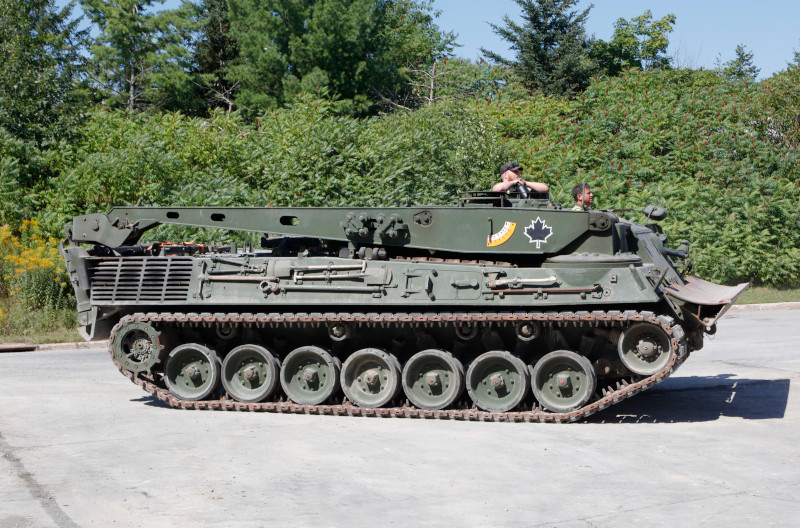
Canadian War Museum
The Leopard 1 “Taurus” armoured recovery vehicle (ARV), acquired in 1979 by Canada, supports damaged or disabled tanks with a 35,000 kg winch and heavy crane. It clears obstacles, constructs berms and can remove tank turrets. Armed with machine guns and a grenade launcher, Taurus served in Afghanistan from 2006 to 2011 with 15 Leopard C2 tanks during Operation ATHENA—the first full Canadian tank squadron deployed since the Korean War.
Max Speed: 62 km/h
Used by Canada: 1979 to present
Crew: 4
Armour: up to 70 mm
Weight: 40.5 tonnes (loaded)
Main Armament: 7.62 mm machine gun and 76 mm multi-barrel grenade launcher
Lynx Mk. II Scout Car
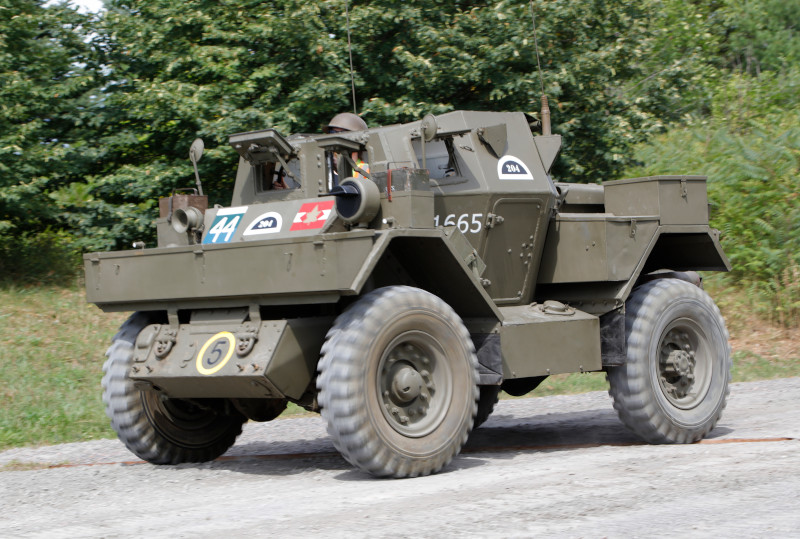
Canadian War Museum
The Canadian-built Lynx Mk. II scout car, derived from the British Dingo, featured a V8 engine and was widely used in WWII, especially in Italy. With improved reliability and mobility over the Mk. I, it came equipped with a Bren gun and radio set. This restored example, still on its original run-flat tires, was acquired by the Canadian War Museum in 1981 from the Greek military.
Max Speed: 95 km/h
Used by Canada: 1941–1945
Crew: 2
Armour: Up to 30 mm thick
Weight: 4.2 tonnes
Armament: Bren LMG or .30 calibre machine gun
Gallery
Iron Will
Vehicles from the Canadian War Museum
“Iron Will” is a video series that explores the history of vehicles in our military technology collection.
Iron Will - 1914 Armoured Autocar
The armoured cars had about 5mm-thick plate armour, which meant it was only bulletproof to about 100 yards. For the centenary of the First World War, the Museum returned it to operating condition.
Iron Will - C15 Armoured Ambulance
There weren't a lot of armoured ambulances in the Second World War. This model was used by the Medical Corps until about 1946, when it was phased out.
Iron Will - FWD Truck
The FWD Truck was an important vehicle widely used during the First World War. It took a number of years for us to assemble the truck to the operating condition you see here.
Iron Will - M1917 Six-Ton Tank
The M1917 Six-Ton Tank was used to train Canadian soldiers at the onset of the Second World War.
Iron Will - The Great Eastern Ramp
This is one of the largest objects currently on display in the LeBreton Gallery. We’re very lucky to have it within the collection because it is the only one in existence.
Iron Will - The Tracked Jeep
This is a prototype vehicle that was intended to be used for light reconnaissance. This vehicle was never used in the war. We acquired it from the owner who was using it in movies.
